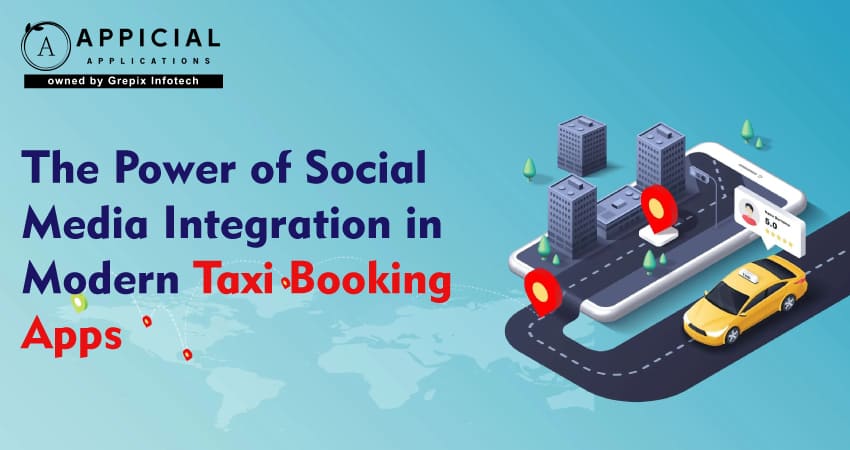
The Power of Social Media Integration in Modern Taxi Booking Apps
Social media is no longer optional. It’s central to how people live, interact, and decide. When taxi booking platforms harness social media directly inside their apps, they gain enormous leverage. Integration means lower friction, deeper engagement, amplified marketing, and higher retention.
For an Uber Clone, ride-sharing app, ride-hailing app, or e-hailing app, social media is a strategic asset, not just decoration.
A white label taxi booking app that lacks social integration misses critical opportunities. Similarly, a white label taxi app development company or taxi app development company that pushes a social-agnostic product will fall behind.
In the sections below, we explore exactly how social media integration adds value, what components matter, how to build them, what questions often arise, and what trade-offs to watch.
IThis blog examines how social media integration enhances modern taxi booking apps. You will learn why social login, sharing, and community features matter. We discuss technical strategies, UX benefits, user acquisition, engagement metrics, and challenges. We see how integration applies to Uber Clone, a ride-sharing app, ride hailing app, and an e-hailing app. We also explore how a white label taxi booking app can leverage social features. Finally, we guide how to choose a white label taxi app development company or a full taxi app development company to build such integration.
Why Is Social Media Integration Crucial for Taxi Apps?
Integrating social media brings multiple benefits. It reduces sign-up friction. It fuels viral growth. It makes the app feel like part of one’s digital identity.
- Faster onboarding: Social login (e.g. Facebook, Google, Twitter) lets users sign up with a tap, reducing form fatigue.
- User profiles enriched: Social integration can auto-import name, photo, email, and even social graph for trust signals.
- Sharing & referrals: Riders can share rides, discounts, driver stories or promotions via social feeds.
- User-driven publicity: Happy customers posting pictures or tagging the taxi brand gives organic exposure.
- Community & rating transparency: Integrating comment threads or social reviews can build trust.
- Social feedback loop: App updates, feature announcements, and promotions shared in social channels keep users engaged.
- Behavioral data: Social integrations help collect insights (interests, social demographics) for personalization.
Because social media platforms are ubiquitous, connecting your Uber Clone or ride-sharing app to them can multiply reach. In fact, one taxi company saw a 40% spike in bookings after a social media post was shared widely.
Globally, taxi apps’ usage is rising fast; over 300 million people use taxi apps globally. The rise in competition means every advantage counts. Social integration is one of those edges.
What Social Media Features Should Taxi Apps Integrate?
Which social media features truly deliver value in a taxi booking context? Here is a breakdown.
Social Login & Single Sign-On
Allow users to log in using Facebook, Google, Twitter, Apple, or LinkedIn. This reduces friction. It also ensures fewer abandoned registrations. For a ride hailing app or e-hailing app, speed matters. A white label taxi booking app must support multiple social login providers. The taxi app development company should design for token refresh, fallback email login, and link/unlink social accounts.
Social Sharing & Referrals
Enable users to share their rides, invoices, driver rating, or referral links in their social feeds. This encourages word-of-mouth. It turns loyal users into promoters. If someone posts “Just had a safe, clean ride via MyTaxiApp,” that acts like free advertising. For an Uber Clone, built-in share options (with image templates) amplify reach.
Social Feed / Activity Stream
Incorporate a small social feed: posts, driver of the month, promotions, ride photos (with permission). This creates a micro-community. Users check not only for rides but for engagement. A ride-sharing app can highlight great driver stories, safety tips, or tips from riders. It increases stickiness.
Ratings, Reviews & Comments Integration
Allow users to comment or “like” reviews, and share them on social media. Make driver feedback public (or partially public). This transparency boosts trust. Users feel heard. For a ride-hailing app, social proof is powerful.
Social Graph-Based Matching & Offers
Use social network data (friends, interests) to personalize offers. For example, if many friends use the app, provide group ride suggestions or friend referrals. You can cross-sell to social clusters. This deep integration helps e-hailing apps differentiate.
Content Sharing (Images, Stories)
Allow riders or drivers to post images (optional) of rides, tags, or stories. With consent, these can appear in the feed or be shareable. This humanizes the app. Social features like “My Ride Today” or “Driver Appreciation” work.
Social Campaigns & Influencer Tags
Launch campaigns tied to social media: hashtag rides, selfie challenges, driver spotlights. Riders tag the app, boosting visibility. Your white label taxi booking app should support campaign modules to tie with social media APIs.
How to Technically Implement Social Media Integration?
Implementing social features in a ride-sharing app, Uber Clone, ride-hailing app, or e-hailing app involves architecture decisions, APIs, privacy, and performance.
Choosing Social APIs & SDKs
Use official SDKs from Facebook, Google, Twitter, Instagram, and Apple. Ensure version compatibility, privacy, and maintenance. The taxi app development company or white label taxi app development company must keep SDKs updated and handle deprecations.
OAuth & Token Management
Social login uses OAuth2. The backend must securely manage tokens, refresh them, and revoke if users unlink accounts. Session management is crucial. Failover to the email login is needed.
Permission Granularity & Privacy
Request only necessary permissions: name, email, profile picture, friend list (if needed). Avoid overreaching permissions. Comply with data protection regulations (e.g. GDPR, local laws). Let users control what is shared publicly.
Social Sharing Integration
Integrate the “share” intent APIs of iOS and Android. Pre-fill share content (ride summary, promotion). Use social SDKs to share on feeds, stories, or direct messages. Allow multiple platforms (Facebook, Instagram, Twitter, WhatsApp).
Backend Support & Data Models
Design data models for social sharing metadata, user posts, comments, likes, and referrals. Scale databases for feed queries. Use caching for popular posts. Maintain ACLs (who can see what). For a white label taxi booking app, modular social modules should be optional.
Real-Time Notifications & Updates
Push notifications for social events: “Your post got likes,” “Friend used a promo,” “Driver shared ride memories.” Use WebSockets or push services. Tie it into the taxi booking flow so notifications feel relevant.
Analytics & Insights
Track shares, referral success, feed engagement, and social conversions. Use these to optimize promotions, UI placements, and campaign ROI. Analytics must tie social metrics with ride data (e.g. rider acquired via social share vs not).
What Are the Business Gains from Social Integration?
Social media integration is not just flashy; it delivers measurable business impact. Here’s how.
Lower Customer Acquisition Cost (CAC)
When users share organically, the app gets free exposure. This reduces spending on paid ads. Social referrals can bring high-quality users. A well-integrated Uber Clone sees better viral loops.
Higher Retention & Engagement
Users will return to view feed, comments, or campaigns. The app becomes more than a utility. A ride hailing app with social features keeps users inside the ecosystem.
Improved Trust & Social Proof
Public reviews, driver highlights, and transparent posts help users trust new drivers or services. This is vital for apps like e-hailing app or ride sharing app where safety perception matters.
Richer User Data & Personalization
Social profiles enrich user data: interests, friend circles, and preferences. This helps tailor offers: e.g. “Your friend John also took this route.” This is powerful for segmenting user campaigns in a white label taxi booking app or custom build.
Also Read: Taxi App Features | Taxi Booking App Features List
Viral Marketing & Brand Awareness
Social content drives brand visibility beyond app walls. Ride stories, user posts, tags all act as marketing. The more integrated, the more reach.
Better Feedback Loops
Comments and shares give direct feedback about which rides or promotions users like. The taxi app development company can iterate faster.
Predictive Demand Modeling
Researchers have shown that social media check-ins and geo-tagged social data can help forecast taxi demand in certain areas. By mining social posts (e.g. event mentions, check-ins), a taxi app can pre-position drivers. This is integration at data level, beyond front-end.
Illustrative Metrics & Trends
The global taxi aggregator apps market is projected to reach USD 880.2 billion by 2034, at a CAGR of 14.8%.
Ride-hailing and taxi apps count over 300 million users globally as of recent reports.
Social media plays a central role in mobile apps: integration improves user engagement, streamlines sharing, and boosts exposure.
Studies show social networks can increase in-app retention, offline behavior, and engagement.
These numbers underline that social integration is not a fringe feature; it is rapidly becoming a baseline expectation.
Conclusion
Integrating social media into modern taxi booking apps is no longer optional. When you build an Uber Clone, ride-sharing app, ride-hailing app, or e-hailing app, social features enhance every aspect: acquisition, engagement, trust, data, and brand reach. A white label taxi booking app platform that supports social modules is highly desirable. A white label taxi app development company or a full taxi app development company that ignores social is limiting your app’s potential.
If you plan to build a sophisticated taxi-booking platform, you need an expert partner who understands both mobility and social dynamics. Appicial Applications excels in integrating social media into taxi apps. They build modern Uber Clone solutions with built-in social login, sharing channels, feeds, comment systems, analytics, and permission models. They consult you on which social platforms to support, how to protect privacy, and how to tie social metrics to ride growth.
Ready to build a ride-hailing app, ride-sharing app, or e-hailing app with powerful social integration? Reach out to Appicial Applications. Let’s build a socially empowered taxi app that scales, engages, and wins users.
FAQs
Author's Bio

Vinay Jain is the Founder at Grepix Infotech and brings over 12 years of entrepreneurial experience. His focus revolves around software & business development and customer satisfaction.
Back to blog list




